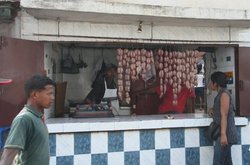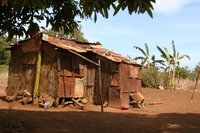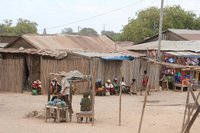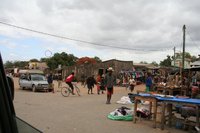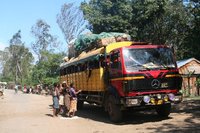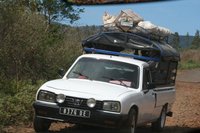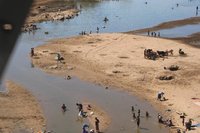 |
 |
Conservation Madagascan life is based on rice and Zebu. With the increase in Madagascar’s population there has been extreme pressure on the land to provide for these people. Forests have been destroyed and the land has been ravaged in an attempt to provide food for the people. As Madagascar has more rare and endemic plants and animals than many other countries, there is a real need to stop this destruction of forest and begin setting aside areas for preservation and conservation. Organisations such as the WWF, Durrell wildlife Conservation Trust and Conservation International are working to ensure the conservation of Malagasy biodiversity and trying to reduce the environmental degradation which is occurring. |
Antananarivo (often abbreviated to Tana) The capital, Tana, with a population exceeding two million, has a distinctively French flavour and atmosphere: French is widely spoken and road, as well as shop signs (such as boulangerie or épicerie), are mostly in French. The streets of central Tana have much old colonial architecture.
Tana was founded in the 17th century by King Andrianjaka, and was the capital of the Hova chiefs. It is located within, and surrounded by twelve sacred hills of the plateau of Imerina. Within the city centre, flights of steps lead up to a rocky ridge at 1,431 m, on which stands the palaces built by the Imerina kings who captured the capital in 1794 and ruled there until the end of the 19th century.
The city is built on three levels. Dominating the city is the Queen's Palace and associated Royal Village or Rova. Now a national monument, it was once the residency of the Merina Dynasty which, in the 19th century, united all Madagascar for the first time. On the lowest level is the famous market of Analakely. The Zuma Market, claimed to be the second largest in the world. GENERAL INFO
Population and Language Half of the 21 million population are under the age of 15 years. The official languages are Malagasy (which is related to Indonesian) and French.. English is only spoken by a very few in the capital. The people are referred to as Malagasy or just 'gasy. (The 'y' is almost silent, and the 's' is aspirated, so the word is pronounced "Malagash"). The population is separated into 18 main ‘tribes’ or clans and consist of a variety of ethnic origins, which include India/Pakistani, Chinese and European origins. Poverty Over 90% of the population lives below the poverty line on less than 2 dollars a day and over 60% of these people are classified as extremely poor. 85% of the children in Antananarivo are undernourished. Madagascar is ranked as one of the poorest countries in the world. However, despite this poverty the people are extremely friendly and welcoming.
Education There is very little public money for financing education and the shortage of teachers has contributed to the falling of education standards. Over one third of Madagascar’s children receive no education. The literacy rate is approximately 45%.
The French still influence the education system with French language being compulsory in schools and all exams are taken in French language.
Laundry Laundry is always done by hand in Madagascar, mostly along the river banks - washing machines are unknown. Currency The Malagasy Ariary exchange rate is 1 GBP = 3,300 Mga or 1 EUR = 2,900 Mga Climate Madagascar has a hot, sub-tropical climate
with cooler weather in the highlands. The
rainy season is from November to March. The
south and west regions are hot and dry with
an erratic rainy season from November to
April. Monsoons bring storms and cyclones
to the north and east from December to March.
The highlands, including the capital, are
warm and sometimes thundery from November
to April and dry, cool and windy the remainder
of the year. Religion Most of the population is nominally Christian (roughly equal numbers of Protestant and Catholic) although over half the population still follow animist beliefs and ancestor worship. Several coastal areas are predominantly Moslem. Food & Drink Traditional Malagasy cooking is based on a large serving of rice with a dressing of sauces, meat, vegetables and seasoning. It is sometimes very hot and spicy. Malagasy beers (Three Horses or Gold) are pilsner lagers and very good. The various rums are also good, especially that from Djamandjar, Nosy Be. There are several large vineyards on the High Plateau which produce red, rosé, white and “grey” (gris) wines. Malagasy drinks include litchel (an aperitif made from litchis), betsa (fermented alcohol) and toaka gasy (distilled from cane sugar and rice). Non-alcoholic drinks include ranon ’apango or rano vda (made from burnt rice) and local mineral waters. Specialities: • Local beef is from the Zebu cattle (a cow with a hump) • Ro (beef and pork marinated in vinegar, water and oil, then cooked with leaves, onion, pickles and other vegetables and seasoned with pimento). • Ravitoto (meat and leaves cooked together). • Ramazava (leaves and pieces of beef and pork browned in oil). • Vary amid ’anana (rice, leaves
or herbs, meat and sometimes shrimps), often
eaten with kitoza (long slices of smoked,
cured or fried meat). Visa These can be obtained from France or at the
airport upon arrival, where they are currently
free but be aware that it’s a long
queue. Communications International phones essentially only work in the capital and international calls are extremely expensive, at about £20-25 per 3 minutes or part thereof. Recently email has become readily available in the capital and is extensively used by all the international agencies. Air mail letters to Europe normally take about 10 days but sometimes longer. Tipping We were advised that tipping is not the general rule, and is usually at a percentage well below 10%. However, in reality people did expect tips. For a hotel porter in Tana who has carried several bags, 1000 Mga would be a typical maximum. Taxi drivers do not expect tips, but you must negotiate the fare before getting in. If in doubt, tip on the low side, since excessive over tipping can cause problems.
| ||||||















